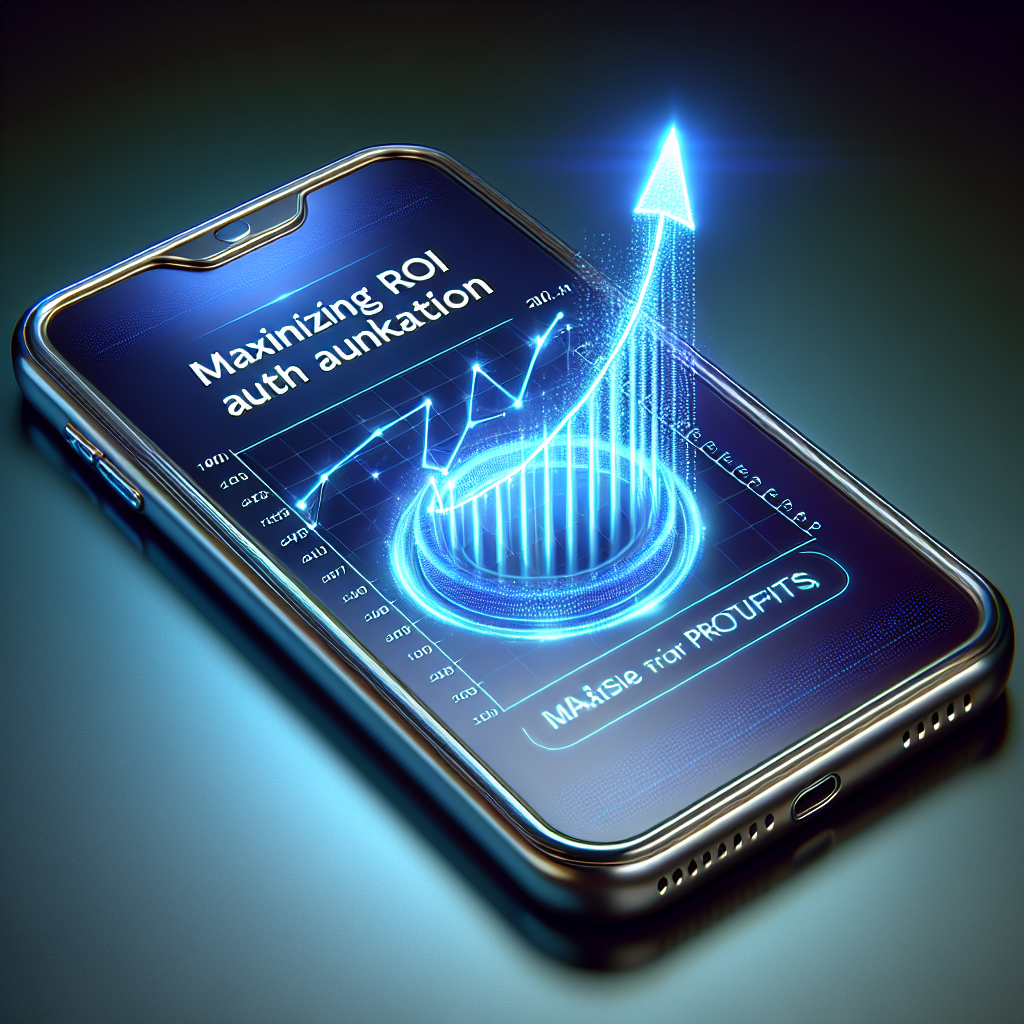Maximizing ROI with marketing automation
Are you looking for ways to maximize your return on investment (ROI) in your marketing efforts? Look no further! In this article, we will explore the world of marketing automation and how it can be a game-changer for your business. From search engine optimization and search engine marketing to social media marketing and content marketing, we will delve into different aspects of marketing automation that can help you streamline your processes, save time, and ultimately boost your ROI. So, let’s dive in and discover the power of marketing automation!

Search Engine Optimization (SEO)
Search Engine Optimization (SEO) is the practice of optimizing your website to improve its visibility and ranking in search engine results pages (SERPs). By implementing SEO strategies, you can increase organic (non-paid) traffic to your website, reach your target audience, and maximize your online presence.
On-page SEO
On-page SEO refers to optimizing elements on your website to improve its search engine ranking. This includes optimizing meta tags, title tags, headings, URLs, and content. By including relevant keywords and providing high-quality, informative content, you can attract both search engines and users to your website.
Off-page SEO
Off-page SEO involves activities that take place outside of your website to improve its visibility and reputation. This can include building backlinks from reputable websites, engaging in social media marketing, and participating in online communities. Off-page SEO can help increase your website’s authority and credibility in the eyes of search engines.
SEO tools
There are various SEO tools available that can assist you in optimizing your website and monitoring its performance. These tools can provide insights into keyword research, competitor analysis, and tracking website rankings. Popular SEO tools include Google Search Console, Moz, SEMrush, and Ahrefs.
Local SEO
Local SEO is a specific type of SEO that focuses on optimizing your website to rank better in local search results. This is particularly important for small businesses that primarily serve a local customer base. By optimizing your website with location-specific keywords, creating a Google My Business profile, and getting positive online reviews, you can increase your visibility in local searches.
Search Engine Marketing (SEM)
Search Engine Marketing (SEM) is a form of online advertising that involves promoting your website and increasing its visibility in search engine results pages through paid advertisements. SEM allows you to reach a larger audience and attract immediate traffic to your website.
Google Ads
Google Ads is the most popular SEM platform, allowing you to create ads that appear on Google Search and other Google properties. With Google Ads, you can target specific keywords, demographics, and locations, and only pay when someone clicks on your ads. This makes it a cost-effective advertising solution for businesses of all sizes.
Bing Ads
Bing Ads is Microsoft’s advertising platform, similar to Google Ads. Although Bing has a smaller market share than Google, it still reaches a significant number of users. By advertising on Bing, you can potentially reach a unique audience and diversify your online marketing efforts.
Paid search advertising
Paid search advertising involves creating and placing ads on search engine results pages. These ads are usually displayed above or below the organic search results and are marked as “sponsored” or “ad.” Paid search advertising allows you to target specific keywords and demographics, track conversions, and optimize your campaigns for maximum ROI.
Ad campaign management
Effective ad campaign management is crucial to achieve success in search engine marketing. This involves setting clear goals, creating compelling ad copy, monitoring and optimizing your campaigns, and analyzing performance metrics. By constantly refining your ad campaigns, you can improve targeting, increase click-through rates, and ultimately maximize your return on investment.
Social Media Marketing
Social Media Marketing is the process of utilizing social media platforms to promote your brand, products, or services. By leveraging the power of social media, you can engage with your target audience, increase brand awareness, and drive traffic to your website.
Facebook marketing
Facebook is the largest social media platform, with billions of active users. By creating a business page, posting engaging content, and utilizing Facebook’s advertising tools, you can effectively reach and engage with your target audience. Facebook marketing can include various strategies such as running ads, creating groups, hosting events, and leveraging user-generated content.
Instagram advertising
Instagram is a highly visual social media platform that is particularly popular among younger demographics. With Instagram advertising, you can showcase your products or services through images and videos, target specific demographics and interests, and drive traffic to your website. Instagram also offers features like “Stories” and “IGTV” that provide additional opportunities for engagement and brand exposure.
Twitter promotion
Twitter is a popular platform for real-time updates, news, and conversations. By utilizing Twitter, you can easily engage with your audience, share content, and promote your brand. Twitter promotion can include activities such as tweeting regularly, participating in relevant conversations, using hashtags, running Twitter ads, and leveraging influencers or partnerships.
LinkedIn marketing strategy
LinkedIn is a professional networking platform that allows businesses to connect with professionals, build relationships, and market their products or services. With a well-defined LinkedIn marketing strategy, you can establish your brand as an industry leader, engage with your target audience through content sharing, join relevant groups and discussions, and utilize LinkedIn’s advertising features to reach specific professional demographics.
Content Marketing
Content Marketing involves creating and distributing valuable and relevant content to attract and engage a target audience. By providing informational, entertaining, or educational content, you can build brand awareness, establish credibility, and drive traffic to your website.
Blog content strategy
A blog content strategy involves planning and creating blog posts that align with your business goals and target audience’s interests. By conducting keyword research, understanding your audience’s needs, and providing valuable and well-optimized content, you can attract organic traffic, generate leads, and position yourself as an industry expert.
Content creation tools
Content creation tools can help streamline the process of producing high-quality and engaging content. These tools can assist with content ideation, planning, writing, editing, and distribution. From keyword research tools to content management systems and social media scheduling platforms, there are numerous tools available to help optimize your content creation process.
Video content marketing
Video content marketing is an effective way to engage with your audience and convey your brand message. With the increasing popularity of video platforms like YouTube and TikTok, creating and sharing videos has become more accessible than ever. By producing informative or entertaining videos, optimizing them for search engines, and promoting them through various channels, you can drive traffic to your website and increase brand visibility.
Infographic promotion
Infographics are visual representations of information or data that are designed to be easily understood and shared. By creating visually appealing and informative infographics, you can attract attention, increase engagement, and enhance your content marketing efforts. Infographic promotion can involve sharing them on your website, social media platforms, and relevant websites, as well as reaching out to influencers or journalists who may be interested in featuring your infographics.

Email Marketing
Email Marketing is the practice of sending targeted emails to a group of individuals to promote your products, services, or brand. By building an email list and delivering valuable content, you can establish relationships with your audience, drive traffic to your website, and ultimately increase conversions.
Email automation
Email automation allows you to automate certain aspects of your email marketing campaigns, making them more efficient and personalized. With email automation, you can set up triggers, such as a user signing up for your newsletter or making a purchase, and send them automated emails based on their actions. This can save time, nurture leads, and improve the overall effectiveness of your email marketing campaigns.
Email campaign optimization
To optimize your email marketing campaigns, it’s important to constantly analyze and improve your email content, design, and targeting. By conducting A/B tests, monitoring open and click-through rates, segmenting your audience, and personalizing your emails, you can optimize your campaigns for better engagement and higher conversions.
Email marketing tools
There are various email marketing tools available that can streamline your email marketing efforts and provide valuable insights. These tools can help you create visually appealing email templates, manage and segment your subscriber lists, track email performance, and automate certain aspects of your email campaigns. Popular email marketing tools include Mailchimp, Constant Contact, and ConvertKit.
Newsletter best practices
Newsletters are a popular form of email marketing that allows you to regularly communicate with your audience, provide valuable content, and promote your products or services. To optimize your newsletters, it’s important to define your goals, segment your subscribers, create engaging content, design visually appealing templates, and track key metrics. By following best practices, you can build a loyal subscriber base and drive traffic to your website.
Digital Analytics
Digital Analytics involves collecting, analyzing, and interpreting data from various online sources to understand user behavior, optimize marketing strategies, and measure the effectiveness of your digital efforts. By leveraging data-driven insights, you can make informed decisions and improve your online marketing results.
Google Analytics tips
Google Analytics is a powerful tool that provides valuable insights into website traffic, visitor behavior, conversions, and more. By utilizing Google Analytics effectively, you can track key metrics, identify high-performing pages or campaigns, understand user demographics, and make data-driven decisions to improve your website’s performance.
Data-driven marketing
Data-driven marketing involves utilizing data and analytics to guide your marketing strategies and tactics. By analyzing consumer behavior, demographics, and preferences, you can create personalized experiences, improve targeting, and optimize your marketing efforts for maximum ROI. Data-driven marketing allows you to make informed decisions and allocate your resources effectively.
Web analytics tools
In addition to Google Analytics, there are various web analytics tools available that can provide deeper insights into your website’s performance. These tools may offer additional features like heat maps, session recordings, and real-time data. Popular web analytics tools include Adobe Analytics, Crazy Egg, and Hotjar.
Analytics reporting
Analytics reporting involves analyzing data and presenting insights in a clear and understandable format. By creating comprehensive reports, you can communicate the impact of your marketing efforts, identify trends, and make data-driven recommendations. Effective analytics reporting can help align stakeholders, justify budget allocations, and drive continuous improvement in your digital marketing strategies.
E-commerce Marketing
E-commerce Marketing refers to the strategies and tactics used to promote and sell products or services online. By implementing effective e-commerce marketing strategies, you can increase sales, improve customer retention, and grow your online business.
Online store optimization
Optimizing your online store involves improving its design, navigation, user experience, and overall functionality. By ensuring your store is easy to navigate, mobile-friendly, and visually appealing, you can enhance user experience and increase conversions. Optimizing your product pages, implementing effective call-to-actions, and offering secure payment options can further improve your online store’s performance.
E-commerce SEO
E-commerce SEO is the practice of optimizing your online store to increase its visibility and ranking in search engine results pages. This involves optimizing product descriptions, titles, URLs, and implementing relevant keywords. By conducting keyword research, optimizing your product pages, and building high-quality backlinks, you can attract organic traffic and drive sales.
Product listing ads
Product listing ads (PLAs) are paid advertisements that showcase individual products with an image, description, and price. PLAs are commonly displayed on search engine results pages and shopping platforms. By creating compelling product listings, optimizing product feeds, and utilizing ad targeting options, you can increase your online store’s visibility and attract potential customers.
Cart abandonment strategies
Cart abandonment occurs when a shopper adds items to their cart but fails to complete the purchase. Implementing strategies to reduce cart abandonment can help you recover lost sales and increase your online store’s conversion rate. Strategies can include sending cart abandonment emails, offering incentives or discounts, simplifying the checkout process, and providing transparent shipping and return policies.
Influencer Marketing
Influencer Marketing involves collaborating with influential individuals in your industry or niche to promote your products, services, or brand. By leveraging the credibility and reach of influencers, you can increase brand awareness, reach new audiences, and drive conversions.
Influencer collaborations
Collaborating with influencers involves partnering with them to create content, endorse your products, or promote your brand. Influencer collaborations can take many forms, such as sponsored posts, giveaways, product reviews, or guest appearances. By selecting relevant influencers and establishing a mutually beneficial partnership, you can tap into their audience, enhance your brand’s reputation, and drive engagement.
Influencer outreach
Influencer outreach is the process of identifying and connecting with relevant influencers to establish partnerships. This can involve researching potential influencers in your industry, reaching out with personalized messages or proposals, and nurturing relationships. Effective influencer outreach can lead to valuable partnerships that amplify your brand’s message and increase your online presence.
Micro-influencers
Micro-influencers are individuals with a smaller but highly engaged following on social media. Collaborating with micro-influencers can be advantageous as they often have a highly niche and loyal audience. By partnering with micro-influencers, you can tap into their dedicated community, increase brand authenticity, and generate more targeted conversions.
Influencer marketing platforms
Influencer marketing platforms provide a marketplace for brands and influencers to connect and collaborate. These platforms often provide tools for finding influencers, managing partnerships, and measuring campaign performance. Prominent influencer marketing platforms include Influencer, Upfluence, and AspireIQ. By utilizing these platforms, you can streamline your influencer marketing efforts and track the success of your campaigns.
Marketing Automation
Marketing Automation involves using software and technology to automate repetitive marketing tasks and streamline processes. By automating various marketing activities, you can save time, increase efficiency, and deliver personalized experiences to your audience.
Definition and benefits
Marketing automation refers to the use of technology and software to automate repetitive marketing tasks and workflows. This can include email automation, social media scheduling, lead nurturing, and personalized content delivery. The benefits of marketing automation include increased efficiency, improved targeting, reduced human error, and the ability to deliver personalized and timely messages to your audience.
Choosing the right marketing automation system
When choosing a marketing automation system, it’s important to consider your specific business needs, budget, and integration capabilities. Look for a system that offers features aligned with your marketing goals, provides intuitive user experience, and integrates well with your existing tools and platforms. Popular marketing automation systems include HubSpot, Marketo, and Pardot.
Setting up marketing automation processes
Setting up marketing automation processes involves defining your goals, mapping out customer journeys, and creating workflows that automate repetitive tasks. This can include lead nurturing workflows, abandoned cart emails, welcome sequences, and personalized content delivery based on user behavior. By carefully planning and implementing your automation processes, you can streamline your marketing efforts and provide a consistent user experience.
Tracking and analyzing marketing automation results
To measure the success of your marketing automation efforts, it’s important to track and analyze key metrics. This can include metrics such as email open rates, click-through rates, conversion rates, and customer retention rates. By analyzing these metrics, you can identify areas for improvement, optimize your automation processes, and continuously refine your marketing strategies for better results.
















It's great that you talked about how business insurance can provide financial protection against unexpected events and help ensure the…
I like that you mentioned how business insurance is essential for protecting your bottom line and the long-term viability of…